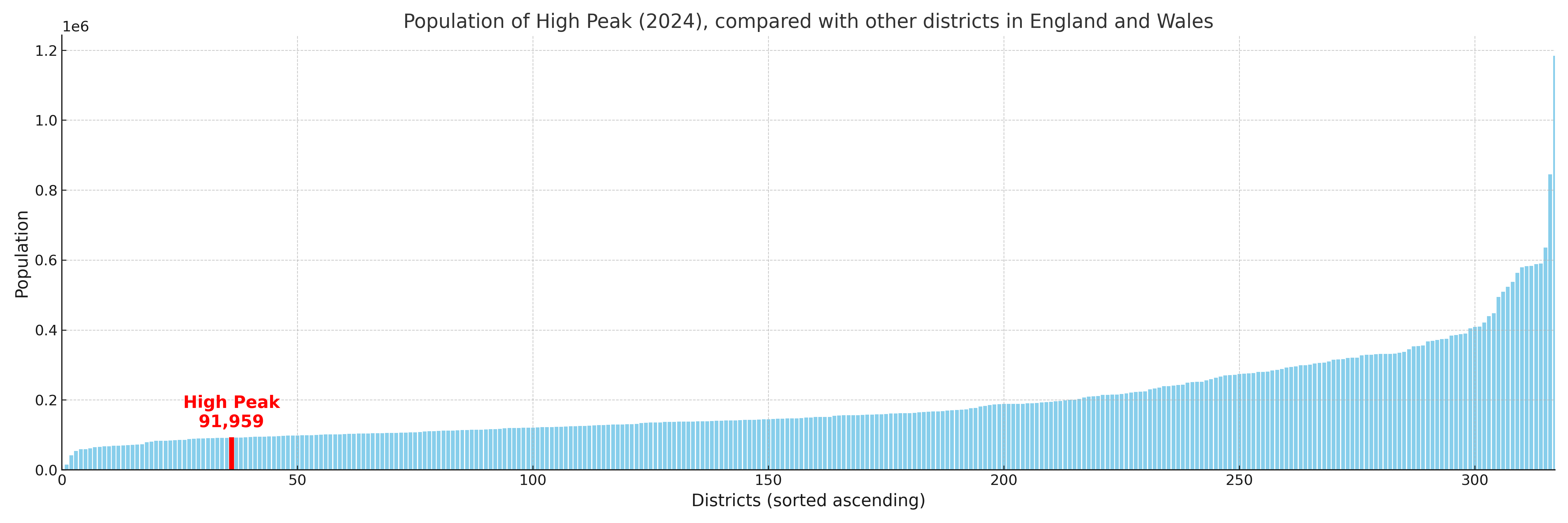High Peak
§ This page gives an overview of the High Peak local authority district, bringing together key facts, maps, and data to help you quickly understand the area. One of 361 district profiles on Baseview.
Overview ⁞ High Peak is a dramatic landscape of moors, reservoirs, and gritstone edges, forming part of the Peak District National Park. The district includes the spa town of Buxton, known for its Georgian and Victorian architecture, natural spring waters, and grand Opera House. Glossop serves as a gateway to the Dark Peak, with rugged terrain and wild expanses ideal for hikers and climbers. Market towns like New Mills and Chapel-en-le-Frith sit among valleys and rivers, while the Kinder Scout plateau and Snake Pass highlight the area’s rugged natural beauty. Its mixture of heritage and untamed scenery makes High Peak a striking district.
High Peak Boundary Map
This map shows the official boundary of the High Peak local authority district, based on the latest geographic data published by the Office for National Statistics (ONS). It provides a clear view of the district’s extent and helps you understand how the area fits within the wider regional and national landscape.
Contains OS data © Crown copyright and database right 2025. Source: Office for National Statistics licensed under the Open Government Licence v3.0.
The administrative boundary of High Peak can also be viewed on OpenStreetMap: District Boundary of High Peak.
Key Facts about High Peak
What region is High Peak in? High Peak is in the East Midlands of England, a region within the UK.
What county is High Peak in? High Peak is located in the county of Derbyshire.
Is High Peak a city? No, High Peak is not a city. (Note: the UK has 76 officially designated cities.)
Who governs High Peak? The local authority for this district is: High Peak Borough Council - responsible for district-level services. Since Derbyshire is a two-tier area, county-level services are handled by: Derbyshire County Council.
▶ Official website of High Peak Borough Council 🔗 highpeak.gov.uk

Which police force covers High Peak? Policing in High Peak is provided by Derbyshire Constabulary 🔗 derbyshire.police.uk, which serves 9 local authority districts: Amber Valley ⁞ Bolsover ⁞ Chesterfield ⁞ Derby ⁞ Derbyshire Dales ⁞ Erewash ⁞ High Peak ⁞ North East Derbyshire ⁞ South Derbyshire.
Constituencies in High Peak
High Peak is divided into 1 parliamentary constituencies, listed below in alphabetical order.
A constituency is a specific geographical area that elects one Member of Parliament (MP) to represent them in the House of Commons. The United Kingdom is divided into 650 parliamentary constituencies. We have this list page for easy browsing of all UK parliamentary constituencies: List of Constituencies.
Wards in High Peak
High Peak is divided into 28 wards, listed below in alphabetical order.
- Barms
- Blackbrook
- Burbage
- Buxton Central
- Chapel East
- Chapel West
- Corbar
- Cote Heath
- Dinting
- Gamesley
- Hadfield North
- Hadfield South
- Hayfield
- Hope Valley
- Howard Town
- Limestone Peak
- New Mills East
- New Mills West
- Old Glossop
- Padfield
- Sett
- Simmondley
- St John's
- Stone Bench
- Temple
- Tintwistle
- Whaley Bridge
- Whitfield
In the UK, a ward is a subdivision of a local authority area, used mainly for electoral and statistical purposes. Defined by the ONS, wards represent the primary unit for local elections, each returning one or more councillors to the local council. Wards are also used as a key geography for presenting population and census data.
Parishes in High Peak
High Peak is part-parished: 22 civil parishes (listed A-Z below) alongside 3 unparished areas.
- Aston
- Bamford
- Brough and Shatton
- Castleton
- Chapel-en-le-Frith
- Charlesworth
- Chinley, Buxworth and Brownside
- Chisworth
- Derwent
- Edale
- Green Fairfield
- Hartington upper Quarter
- Hayfield
- Hope
- Hope Woodlands
- King Sterndale
- New Mills
- Peak Forest
- Thornhill
- Tintwistle
- Whaley Bridge
- Wormhill
A civil parish is the lowest tier of local government in England, used for villages, small towns, and suburbs. They have their own local authority, either a parish council or a parish meeting, which provides local services like managing parks, allotments, and streetlights, and represents the community's views to larger councils.
Built-up Areas in High Peak
High Peak covers 22 built-up areas, listed below in alphabetical order.
- Bamford
- Batham Gate
- Birch Vale
- Bradwell (Derbyshire Dales) *
- Broadbottom *
- Buxton (High Peak)
- Castleton (High Peak)
- Chapel-en-le-Frith
- Charlesworth
- Chinley
- Dove Holes
- Furness Vale
- Gamesley
- Glossop
- Hadfield *
- Harpur Hill
- Hayfield
- Hope (High Peak)
- New Mills *
- Padfield
- Tunstead
- Whaley Bridge
In the UK, a Built-up Area (BUA) is a continuous urban area of at least 20 hectares (0.2 km²), defined by the ONS as land where buildings are generally no more than 200 metres apart, such as towns, cities, or large villages. (Note: A BUA name marked with an asterisk (*) indicates that the area is situated partly in the district of High Peak.)
High Peak compared with other districts in the UK
This section shows how High Peak compares with other local authority districts in the UK, using a variety of measures and rankings.
High Peak has 28 electoral wards.

High Peak has a population of 91,959 (2024 mid-year estimate by ONS)

More local statistics and data for High Peak can be found on the ONS statistics for High Peak.